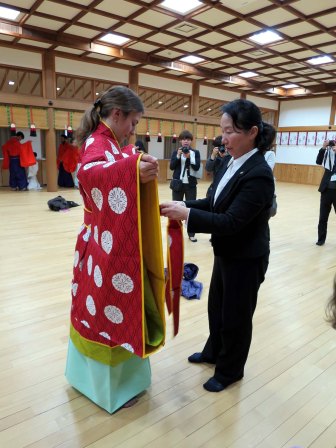Today was a fun mixture of introductory lectures and hands-on experiential learning. In the morning, we had a visit from representatives of Ise’s Industry and Tourism department, and we were given an overview of Ise’s general features, sites, and events by the associate director, Susaki Mitsuhiro. Although there are too many great new things to go through them all, a few stuck with me.
One is two major ceremonies that are associated with the Ise Grand Shrine, okihiki お木曳 and oshirashimochi お白石持. In the okihiki, the timber cut for the rebuilding of the Ise shrine is carried by local residents from the log ponds to shrine site. It is thought that since the medieval period residents of the Ise area were able to pay their annual tribute taxes in the form of labor for this kind of preparation for the shrine’s construction. The oshirashimochi is another community event whereby stones from the Miya river are collected by the people of Ise, washed, and carried to the shrine to be placed there as part of the installation. From these examples it is easy to see how deeply embedded Shintō traditions are as a means of community-building and mutual support.

Susaki-san also explained a bit about how the city has handled the desire to increase tourism both domestically and internationally. At the time of the last reconstruction of Ise shrine twenty years ago, the city made a dedicated effort to revitalize the cityscape. Rather than maintain a more modern, busy image full of electric signs and metal telephone poles, the city worked with local businesses to unclutter the streets, repave, and build structures with more traditional architecture that would reflect the deeply traditional roots of Ise as a city. You can see an example from one our presentations above.

At the same time, there has been a great deal of outreach on the part of the government to find international parallels to Ise’s role in Japan. Not long ago, the mayor of Ise visited Canterbury, England to meet with the mayor there. Ise’s long-standing history as a pilgrimage site in Japan has made its representatives keen to demonstrate its significance in line with similar sites as well-known to the West as Canterbury.
In the afternoon we had two lectures, one on the history of Ise Grand Shrine from ancient times and one on Ise shrine’s matsuri and festivals in general. The latter professor explained the nature of many matsuri in Japan, particularly those connected to important imperial rituals and Ise shrine. While the word matsuri 祭りis often translated into English as “festival,” our speaker wished to emphasize that matsuri are much more than a word like festival (which is nowadays taken in a secular context) implies. Matsuri are intimately connected with Shintō ritual and occur numerous times per year in all areas of Japan. While some traditions have the same purpose, many are specific in various ways to the individual localities in which they occur. Most often these ritual celebrations are performed with the goal of pacifying spirits, enshrining deities, worshipping kami (spirits/gods), praying for good harvests, driving away evil spirits, averting calamities, praying for peace, etc. Ise, a center of ritual and the shrine of the sun goddess Amaterasu, being inseparably connected to the imperial line (which is said to have sprung from Amaterasu), plays an important role in many matsuri and rituals intended to celebrate and protect the entire country.

With ritual still in mind, our final event of the day was to visit the ritual classroom (saishiki kyōshitsu 祭式教室), where one of the Shintō specialists introduced us to the rituals performed by priests in the enshrining of deities. Particular details we would not have otherwise known, such as the fact that when one opens the door to welcome in a deity, the door must creak for it to be properly welcomed, gave a colorful and personal flavor to learning about rituals one typically thinks of as austere. We were welcomed up to the inside of the shrine steps and provided with various details about the process of performing ritual tasks. We were also welcomed to watch a video in English about Shintō tradition and practical practices such as proper bowing, ritual purification, etc.

Finally, participants were invited to don the outfits of priests and priestess of varying ranks. The women and men were divided into groups with their own individual helpers and we picked out various colors for the three-layered Shintō outfits. After much fussing, explanation, and awkward experiences as tall foreigners, it was a fun experience for everyone.
After we were all dressed and took pictures, our host gave further explanations about ritual practices with shaku (ritual batons) which the men held and the fans which the women held. Each group was invited to practice proper holding and bowing techniques. The entire time we were being observed by four reporters for the Mainichi Shinbun, a well-known newspaper. Three of us (including myself) were asked about our interests in Ise and how we found the city. Again and again we can feel the welcoming atmosphere of a city excited for others to take part in its history and culture.

There were a lot of fantastic photos of us in (and goofing around in) our Shintō outfits, so be sure to check out the gallery for photos from Day 3!